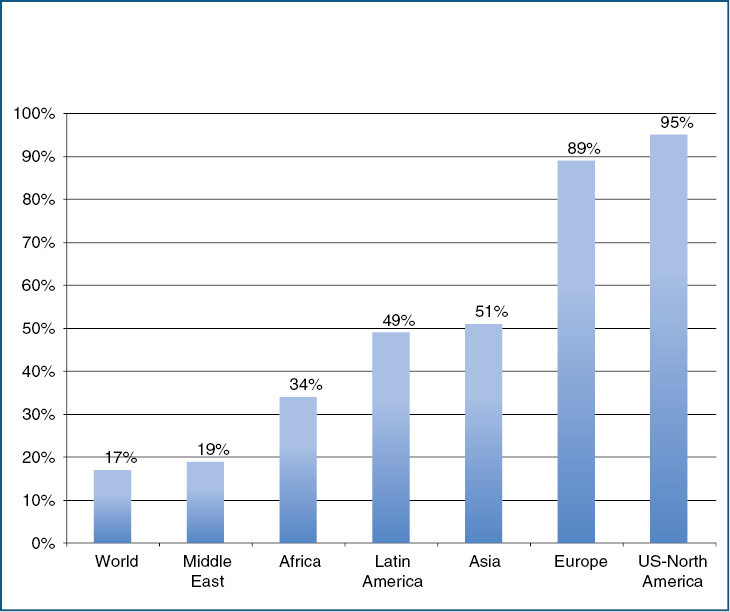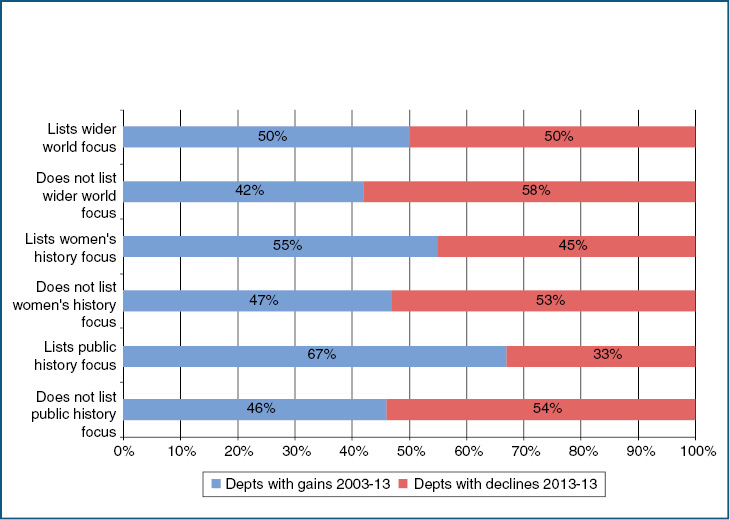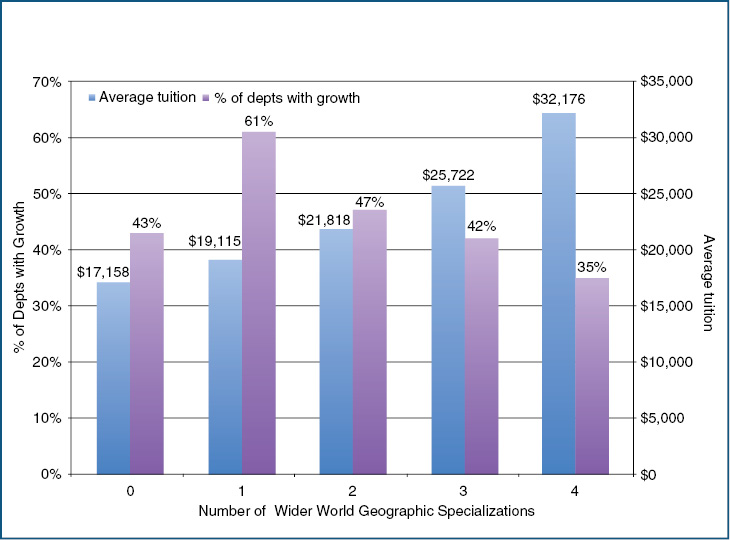News
Department Specializations and the History Major
What We Learned from the AHA’s 2014–15 Directory
What are history departments offering, and how well do those offerings match student interests? We recently lined up departments’ self-reported specializations with data on completion of the history BA. We found that history departments listing a specialization in “wider world” histories, women’s history, and African American history were more likely to have increased their share of bachelor’s degrees than departments without these specializations. We found similar patterns among departments that have a public history specialization, and also found that, despite the concerns of some advocates over an eclipse of the West, a wide majority of departments continue to list themselves as having a specialization in the US and Europe.
We have been watching the health of the history major carefully, and this article is the first of several efforts to look deeply into the data to understand why some departments are growing even as the history major overall appears stagnant. While the raw number of history bachelor’s degrees has risen steadily, if slowly, history’s share of all bachelor’s degrees has been relatively flat for many years; in most recent years it has seen a slight dip (see Perspectives, March 2014). But this downturn has not been experienced by all. Many history departments are increasing both their numbers of majors and their share of their institutions’ bachelor’s degrees. With this in mind, we returned to completions data from the Department of Education and the AHA’s most recent Directory of History Departments, Historical Organizations, and Historians (2014).
Virtually all of the 650 departments listed in the Directory claim US history as an area of specialization. US history is not being replaced wholesale when departments include other parts of the world among their specializations (fig. 1). The example of Asia is instructive—in 2010, 80 percent of departments had at least one historian focused on Asia (Perspectives, September 2011). But only 51 percent of departments listed “Asia” as a departmental focus for the 2014 Directory, suggesting that departments are not laying claim to fields in which they have only a few faculty working, and instead are making an earnest attempt to describe what their departments are best at and what they’d like to be known for, even as they expand their scope.
Figure 1. History Departments’ Geographic Specializations

The graph above shows the percentage of departments listing themselves as having a specialization in a given geographic area. Source: AHA’s Directory of History Departments, Historical Organizations, and Historians, 2014-15.
We will focus here on “market share,” or what proportion of all bachelor’s degrees are history degrees. This helps us account for the fact that the overall college population has grown; most departments have graduated more students than 10 years ago—but often this is not enough to keep their share of all bachelor’s degrees for that institution from slipping. Between 2003 and 2013, 48 percent of departments in the Directory saw an increase in their share of bachelor’s degrees granted by their institution. But a small majority—52 percent—saw a decrease.
However, the subset of departments that report at least one wider world specialization (not United States, not Europe) has an even split. Half of these departments saw a decrease in their share of completions of the bachelor’s; half saw an increase. But among the relatively small number of departments that did not list a wider world geographic specialization, 58 percent saw their share decrease (fig. 2).
Figure 2. Gains and Losses for Select Areas of Specialization

A minority of history departments in the directory (48 percent) increased their share of their institution’s bachelor’s degrees from 2003 to 2013. But certain departmental specializations are associated with a greater likelihood of an increase in “market share.” Sources: AHA’s 2014–15 Directory and the National Center for Education Statistics (NCES).
Eighty-four departments listed women’s history or gender as a specialization. Among these departments, 55 percent saw an increase in the share of bachelor’s completions from their institution. And among those institutions that did not list women’s history as a specialization, 53 percent saw a declining market share. And although very few programs listed themselves in the Directory with an African American history focus, these programs did very well by comparison—63 percent made gains.
But the group that included a public history or museum studies focus did even better. Among these 82 programs, 67 percent made gains—remarkable when contrasted with the record of all the departments in the directory, 52 percent of which saw their share of their intuition’s bachelor’s degrees decline.
Any exploration of factors that contribute to growth in history majors should include discussion of tuition, and a fuller account of tuition as a factor will be part of future articles. But how tuition relates to geographic specializations is surprising. Departments in the directory that saw increases had a significantly lower tuition, on average ($18,000), than those that saw declines in their share of bachelor’s degrees ($25,000). And there is a strong correlation between a higher number of wider world specializations listed by a department and higher average tuition (fig. 3).
Figure 3. Tuition and Geographic Range

Departments with a larger number of wider world specializations are more likely to be found in more expensive schools. More expensive schools have proportionally fewer departments with growth. But departments with just one wider world specialization still have a high proportion of growing departments. Sources: AHA’s 2014 Directory, NCES.
So if tuition were the dominant factor in whether a department’s share of bachelor’s degrees expanded or contracted, we might expect the proportion of growing departments to consistently get smaller with the addition of more specializations. But departments with one or two wider world specializations did better, as a group, than the less expensive group that had no wider world specializations. On the other hand, the more expensive programs with three wider world specializations had about the same proportion of growing departments as the group that listed only Western specializations. Four wider world specializations correlates to much higher tuition and a much higher proportion of departments with declining shares of bachelor’s degrees.
This is all suggestive, not definitive. It tells us that certain subjects are associated with more successful marketing of the major, and to what degree, but not that these subjects caused the growth. And even among those subjects associated with growth, the high percentage of programs that have seen losses is cause for concern. But paring down programs to a few core specialties, or stripping away specialties sometimes regarded as peripheral—such as women’s history, histories of the wider world, or public history—does not appear to be a solution.
Allen Mikaelian is the editor of Perspectives on History.

This work is licensed under a Creative Commons Attribution-NonCommercial-NoDerivatives 4.0 International License. Attribution must provide author name, article title, Perspectives on History, date of publication, and a link to this page. This license applies only to the article, not to text or images used here by permission.
The American Historical Association welcomes comments in the discussion area below, at AHA Communities, and in letters to the editor. Please read our commenting and letters policy before submitting.
Tags: History News Resources for History Departments Resources for Undergraduates Teaching Resources and Strategies The History Major
Comment
Please read our commenting and letters policy before submitting.






